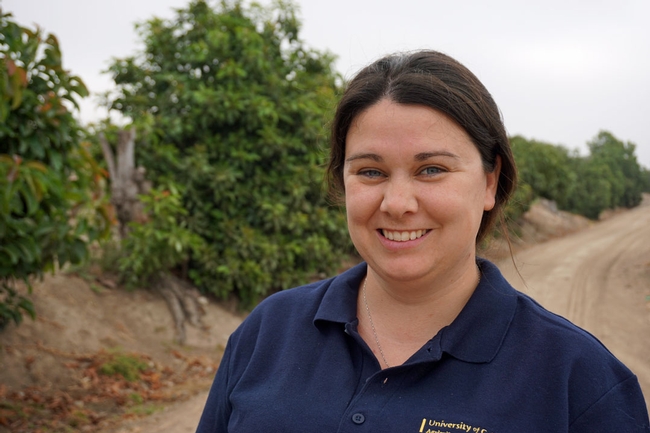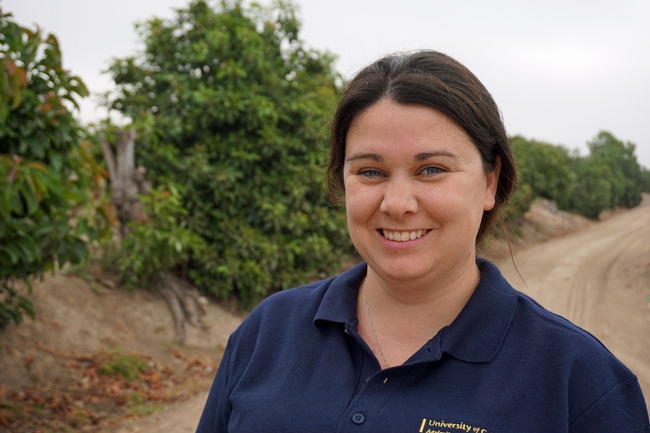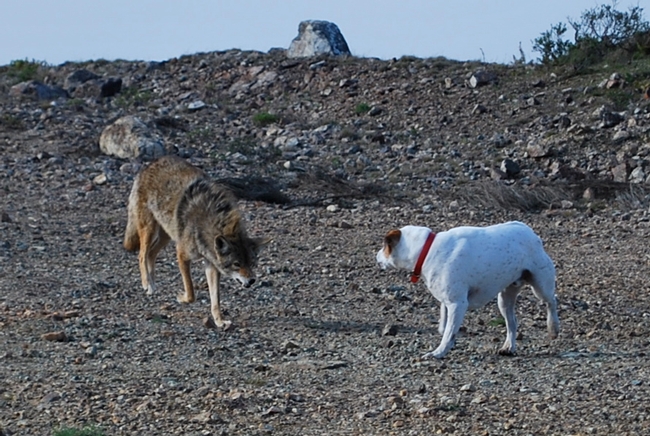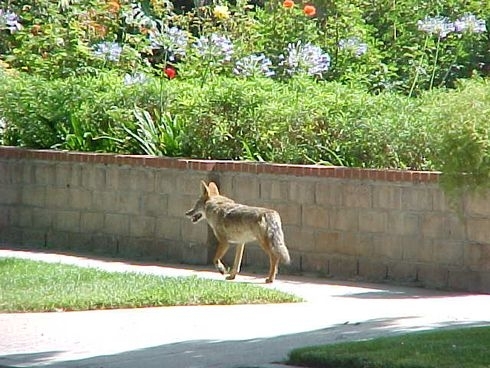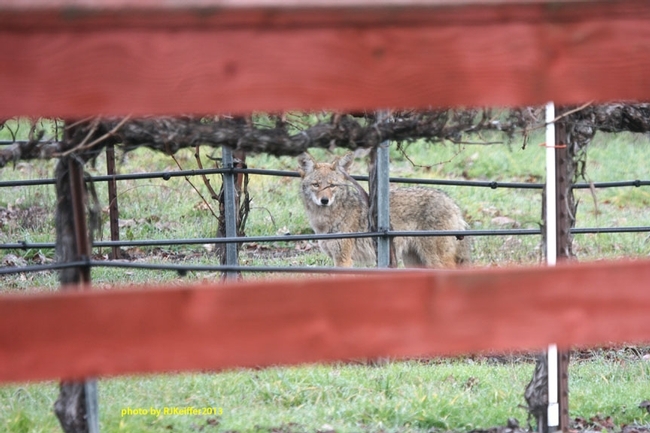Posts Tagged: coyotes
UCCE researcher studies urban coyotes
Some people believe shouting, waving arms and flashing lights will keep coyotes at bay, but UC Cooperative Extenison wildlife-human interaction advisor Niamh Quinn isn't so sure, reported Louis Sahagun in the Los Angeles Times. Like any scientist, she is now conducting a research project to understand whether such hazing deters the wild animals from making their homes in urban areas.
"There is no scientific evidence that hazing alters the behavior of urban coyotes," Quinn said."Yet, it is being pitched as a good option for coyote management."
Quinn is trapping coyotes, sedating them, attaching radio collars, tagging their ears and tracking their movements to understand whether the techniques recommended by some cities and animal rights groups are effective.
“We want to figure out when, where and for how long it actually works, or if it even works at all,” she said. “For the sake of our communities, and coyotes, too.”
UC scientist analyzes coyote stomach contents to study diet
Shoes with rubber soles, western cottontail rabbits, birds, avocados, oranges, peaches, candy wrappers and fast-food cartons were among the contents that UC Cooperative Extension human-wildlife interactions advisor Niamh Quinn has found inside the stomachs of urban coyotes, reported Louis Sahagun in the Los Angeles Times.
Quinn is working with Cal State Fullerton graduate student Danielle Martinez to get a clear picture of what is sustaining coyotes that died across Los Angeles and Orange counties.
"This much is clear: coyotes aren't struggling in our urban environments," Quinn said. "They are almost everywhere, continually learning to adapt alongside us."
Quinn also developed the Coyote Cacher web application to catalog reports of coyote sightings throughout California. Users can see when and where coyote interactions occurred.
"Was howling at an ambulance going down PCH toward Hoag Hospital in Newport Beach," a report posted this month said.
"Killed and ate my cat," said another from the same area.
The stomach contents study indicates that cats make up only about 8 percent of the urban coyotes' diets. Dogs aren't part of the study because it would be difficult to differentiate the DNA of coyotes from other members of the canid family.
Coyotes are getting comfortable in Southern California
In another sign of growing frustration with wildlife in Southern California residential areas, a coyote was shot and killed in a Silver Lake neighborhood by an unknown suspect in June, reported Nina Agrawal in the Los Angeles Times. Residents are taking to social media to commiserate about increasingly bold coyotes, and actions taken to control them.
"It's very disconcerting. Are they coyote vigilantes or something?” the Times quoted one resident.
In a report presented to the L.A. City Council, the Department of Animal Services said its agency, the California Department of Fish and Wildlife and National Park Service had reached a consensus that the coyote population has not grown. The statewide population is between 250,000 and 750,000.
“They're not coming from anywhere, they're just here,” said Niamh Quinn, UC Cooperative Extension vertebrate pest management advisor who specializes in managing human-wildlife conflict. “They're now established in urban communities and they're reproducing successfully.”
Some Southern Californians believe the coyotes move to urban areas because of food and water shortages in the nearby hills, but Quinn disagrees.
“The coyote is going to try to expend the least amount of energy to get the maximum amount of food,” Quinn said. “Why would you stay in a more rural area where you have to go catch a rabbit when you can stick your head in a garbage can and get the same nourishment?”
Southern California grapples with increasing number of coyotes
Coyotes are much more abundant now in urban areas of Southern California than they have ever been before, reported in the Long Beach Business Journal. For the story, the Journal interviewed UC Agriculture and Natural Resources emeritus Cooperative Extension specialist Bob Timm in their Long Beach offices.
Timm, who served as director of the UC Hopland Research and Extension Center in Mendocino County, has 27 years of experience dealing with coyote management.
Timm said coyotes can find ample food in suburban and urban areas by scrounging through garbage and compost piles, eating pet food and even small dogs and cats. Water is available in ponds, birdbaths and pools. Some people intentionally feed coyotes.
“The difficulty is there is so little research on coyotes in suburban and urban areas because it is so hard to do,” Timm said.
Research conducted in the early 2000s by Timm and a Cal Poly Pomona professors found that coyotes habituate in urban areas in a predictable manner than can be observed along the following seven steps:
- Increased coyote presence on streets and in yards at night
- An increase in coyotes non-aggressively approaching adults and/or taking pets at night
- Coyotes present on streets or in parks and yards during morning or afternoon hours
- Coyotes chasing or taking pets in the daytime
- Coyotes attacking or taking pets while they are on a leash or near their owners, and coyotes chasing joggers, bicyclists, and other adults
- Coyotes present around children's play areas, schools or parks in the midday hours
- Coyotes acting aggressively toward adults in midday hours
“One of those steps is they start attacking and killing pets,” Timm said. “When they start doing that in the daytime, then it becomes very problematic and some of those coyotes are eventually going to become aggressive toward people."
According to Niamh Quinn, the UC ANR Cooperative Extension area vertebrate pest advisor, based at the UC ANR South Coast Research and Extension Center, there were six recorded coyote bites on humans in Irvine this year.
Non-lethal predator wildlife control helps keep livestock safe
Five guard dogs are part of the team protecting sheep at a UC Agriculture and Natural Resources (UC ANR) research center in Mendocino County. The director of the UC Hopland Research and Extension Center (HREC) Kim Rodriguez is optimistic the dogs and other non-lethal wildlife control efforts being used at the station will allow peaceful grazing animals to share land with natural predators, reported Sarah Reith in the Ukiah Daily Journal.
Rodrigues initiated a new standard operating procedure (SOP) at Hopland early this year for predator animal control. The policy involves guard dogs, improved fencing and pasture management to protect sheep from coyotes, rather than shooting the predators. Jim Lewers, senior animal technician at HREC, said the "losses have declined" since the new policy was put in place.
Hannah Bird, HREC community educator, said 10 sheep at the center were killed by coyotes in 2015, while 43 were killed in 2014.
Rodrigues told the reporter that it is hard to attribute declines in animal deaths to a single strategy. She hopes to eventually make Hopland a hub for research and information sharing with local landowners on wildlife control.
That effort begins next week. On Dec. 1 and 2, HREC will offer two separate workshops on wildlife management. The first day will include representatives from USDA Wildlife Services, the California Dept. of Fish and Wildlife, and Defenders of Wildlife. On the second day, local ranchers and UC ANR representatives will speak about their chosen methods of wildlife management. Registration is $30 per day. Registration for the two days is separate, and the deadline is Saturday, Nov. 28.
Click here to register for the Dec. 1 workshop.
Click here to register for the Dec. 2 workshop.

